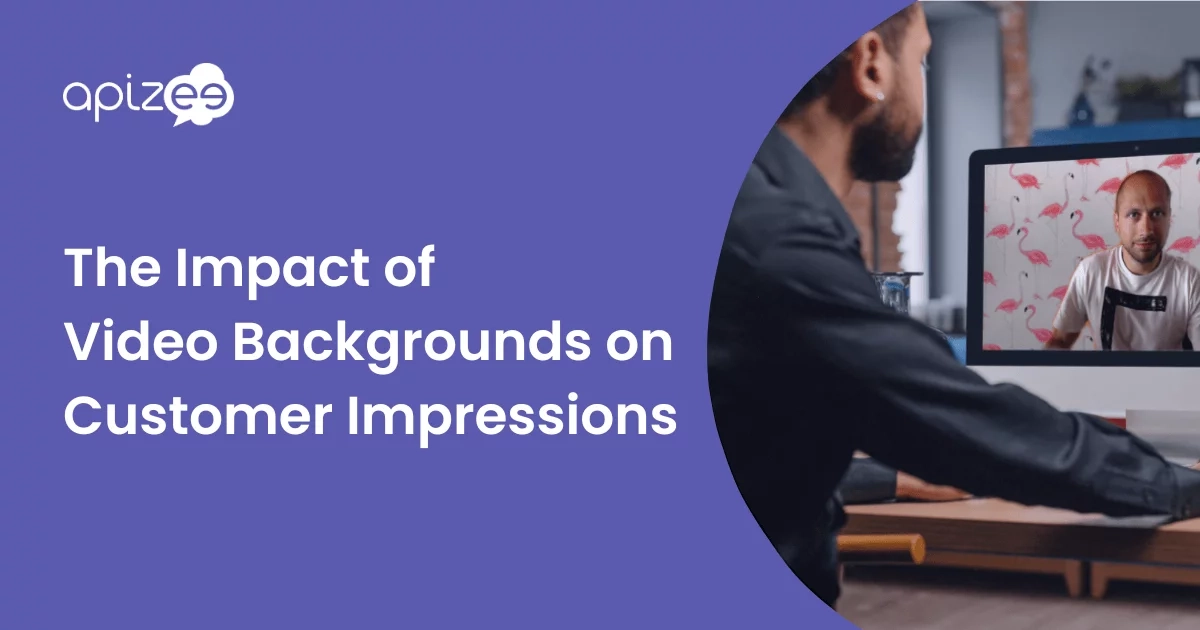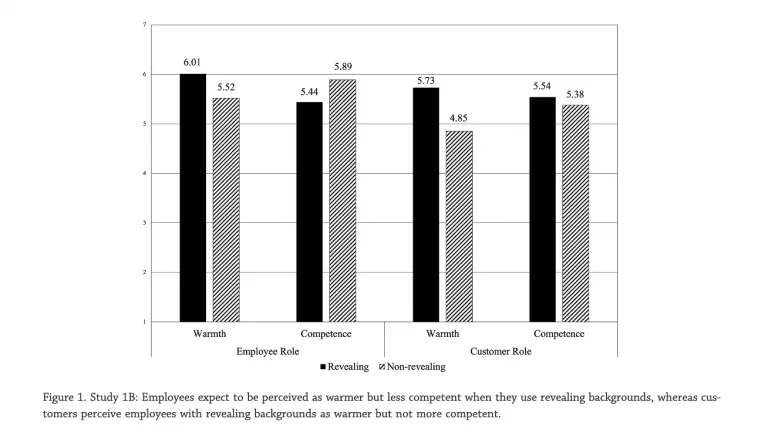The Impact of Video Backgrounds on Customer
Impressions



In today’s digital age, virtual technologies have transformed the way businesses interact with customers. With the advent of videoconferencing, firms and their employees can now engage in face-to-face sales and service delivery, even in online settings. This technology has become particularly vital during the COVID-19 pandemic, as it offered the only means for firms to maintain face-to-face contact with customers when physical restrictions were in place.
Although many restrictions have been lifted, the use of videoconferencing remains prevalent, with 36% of customers anticipating its continued use for interacting with brands. As a result, videoconferencing has become an integral part of creating a seamless omnichannel customer experience.
However, when it comes to videoconferencing, the choice of background can significantly impact customers’ impressions of the employees and the firm they represent. A recent research study sheds light on the importance of background choices and reveals a surprising discrepancy between employees and customers’ preferences.
Traditionally, popular advice suggested that employees should opt for a neutral background during video calls. Entrepreneur magazine suggested choosing a neutral background and avoiding displaying personal items like family pictures. A customer service blog supported these suggestions, recommending an empty wall as the best option. However, Room Rater, a popular Twitter account, argued against plain wall backgrounds, dubbing them “hostage video” backgrounds. So, which backgrounds do employees and customers actually prefer, and how do these choices influence customers’ perceptions, judgments, and behaviors?
New research conducted by Feyzan Karabulut, Sarah G. Moore, and Paul R. Messinger of the University of Alberta’s School of Business, explores employees’ self-presentation strategies in online video-based channels, such as videoconferences or visual assistance. The study focused on the revealingness of video backgrounds—whether the background conveys information about the employee’s personality and preferences. Surprisingly, the findings revealed a miscalibration in employees’ background choices. While employees preferred nonrevealing backgrounds, customers had a preference for revealing backgrounds. The researchers identified two universal dimensions of social judgment—warmth and competence—as the drivers of these divergent preferences.
In the realm of videoconferences, the background image that appears behind us has emerged as a powerful tool for impression management. Whether it’s a real environment like a cozy kitchen or a virtual scene inspired by Star Wars, the background holds the potential to significantly influence how others perceive us. The good news is that we have the ability to control this background and leverage it as a means to create a positive impression.
According to the survey conducted, a staggering 83% of respondents agreed that having control over their background allows them to maximize their ability to make a favorable impression. This newfound control offers individuals the opportunity to curate their surroundings and present themselves in the best possible light. It’s no wonder that more than half of the respondents, 53% to be precise, admitted that they form initial impressions of the person they are conversing with based on their background.
The background image in videoconferences serves as a visual cue that conveys information about our personality, preferences, and even our professionalism. Whether it’s a glimpse into our personal lives or a reflection of our interests, the background image adds depth and context to our interactions. It creates a unique opportunity to project warmth and competence simultaneously.
Fortunately, the advent of virtual backgrounds has expanded the creative possibilities even further. With virtual backgrounds, individuals can transport themselves to virtually any setting they desire, from serene landscapes to iconic movie scenes. This allows for a level of self-expression and customization that can reinforce the impression we want to make.
By utilizing revealing backgrounds, we can tap into the universal dimensions of social judgment: warmth and competence. Sharing glimpses of our personal lives, such as a real background showcasing a cozy kitchen or a virtual background inspired by our favorite movie, helps establish a sense of warmth and relatability. Simultaneously, projecting competence through a well-curated background demonstrates professionalism and attention to detail.
Your background image in videoconferences has become a powerful instrument for impression management. The ability to control and shape our background empowers us to create a positive impression and connect with others on a deeper level. With the majority of people recognizing the impact of background on their perception, it’s clear that leveraging revealing backgrounds can significantly enhance our ability to project warmth and competence. So, let’s embrace this and use it to our advantage in the world of video customer support.
“People have a tendency to choose the “wrong” background – but the “right” one can elevate your image.” They believe that the generic plain background is the best because it is more professional. Our findings, however, suggest the opposite. So, if you’re a fan, go for that Star Wars image!” – Feyzan Karabulut, Alberta School of Business

Understanding the implications of this new research can have a significant impact on both employees and firms, providing valuable insights into optimizing customer video interactions. By examining the different priorities of employees and customers, we can identify strategies that enhance competence perception while fostering warmth and sincerity.
Contrary to popular belief, studies reveal that nonrevealing backgrounds do not necessarily make employees appear more competent. In fact, findings indicate that revealing backgrounds have the potential to make employees seem friendlier and more sincere. This challenges the notion that nonrevealing backgrounds inherently convey competence, highlighting the importance of reevaluating these beliefs.
For employees, it becomes crucial to recognize that prioritizing competence perception does not necessarily require a nonrevealing background. Instead, embracing revealing backgrounds can contribute to creating a more positive impression. Demonstrating warmth and sincerity through personal and pleasant background choices can help employees establish stronger connections with customers.
Experiments demonstrate the tangible benefits of using revealing backgrounds in customer-service interactions. Customers express higher satisfaction levels when employees utilize revealing backgrounds, indicating a preference for friendly and warm interactions. Additionally, customers are more likely to engage with these employees again and recommend them to others. These positive outcomes underline the potential for revealing backgrounds to foster stronger customer relationships and generate positive word-of-mouth referrals.
However, not all exposing backgrounds are created equal. A filthy room or your GIANT insect collection as video background may leave a worse impression than a simple wall that doesn’t expose anything. So people should make sure that what their background reveals—whether it is real or virtual—is pleasant as well as personal.
As remote video support continues to be a vital communication channel, these insights into background selection and impression management can have a lasting impact on customer perceptions and the success of customer-service interactions.

The research on video backgrounds opens up opportunities for further exploration. While the study focused on the revealingness of backgrounds, future research could delve into other aspects such as the type of images displayed, whether real or virtual. Preliminary findings suggest that customers might perceive employees using virtual backgrounds, especially nonrevealing ones, as withholding personal information, potentially impacting trust and satisfaction levels. Understanding the role of different image types and their interaction with background revealingness could provide valuable insights.
The COVID-19 pandemic has solidified the use of virtual communication technologies in customer service. As videoconferencing blurs the boundaries between personal and professional lives, onscreen backgrounds offer a powerful self-presentation tool that allows employees to control the amount of personal information revealed to customers. Future research should further explore the convergence of personal and professional lives and investigate the impact of self-presentation in the context of new technologies.
In conclusion, the choice of background during video calls can significantly shape customers’ impressions of employees and their companies. By aligning their background choices with customer preferences, employees can positively influence customer judgments and behaviors, ultimately enhancing customer satisfaction and engagement.
Start making an impression with your customers, learn more about Apizee today!
Call center scripts shouldn’t become crutches for your agents. Here are five best practices to turn yours into guides for natural conversation.
5 Call Center Script Best Practices for Engaging, Humanized Interactions
11 Apr 2024
If you want long-term insurance customer retention, you need to offer value and build relationships. Here are 11 strategies that help you do both.
Insurance Customer Retention: 11 Best Strategies To Encourage Loyalty
5 Apr 2024
Learn about 14 of the most insightful customer experience metrics you can measure. Plus, how to calculate your own benchmarks and improve them.
14 Must-Know Customer Experience Metrics To Boost Retention and Revenue
29 Mar 2024
Interested in our solutions?